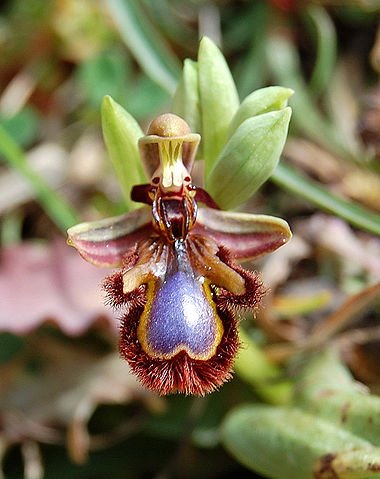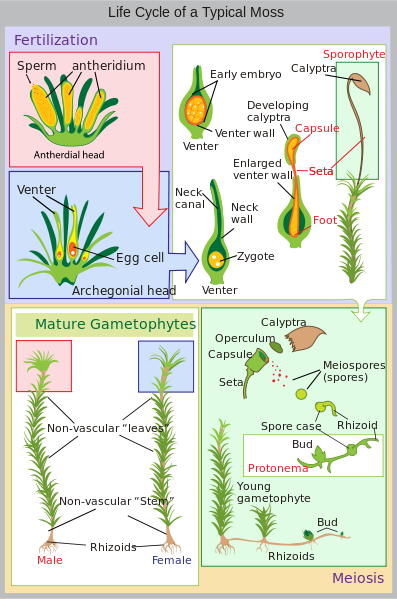A SIMPLE EXPLANATION ON REPRODUCTION IN FLOWERING PLANTS
Hello, dear readers. Today I will like to discuss the reproduction in flowering plants. I'm starting with an introduction on whether the Earth does move for plants, and then go on to discuss how difficult it is for plants to have sex amongst other interesting subjects.
INTRODUCTION: Does the Earth move for plants?
Sex is difficult when you live on land and can’t move. Sperm can’t swim over dry land, so how can genetic information pass from one individual to another? The flowering plants have evolved in close association with the insects, and many plants use animal couriers to transfer their sex cells for them.

Ophrys speculum subsp. speculum. The Mirror Orchid, Esculapio, CC BY-SA 2.5
But how do plants attract the insect? It pays to advertise: brightly coloured flowers promise freebies such as pollen and nectar, but one of the most bizarre strategies has to be the promise of sex.
The mirror orchid of the western Mediterranean has flowers of metallic blue fringed by a yellow band and surrounded by hairs. On either side are two striped lobes that look like wings. In short, mirror orchid flowers are an almost perfect mimic of the rear end of a female bee. And if that wasn’t enough, the flower oozes the pheromone of a sexually receptive female.
Unable to resist, the male homes in and lands on the flower in the correct position for copulation. Before he realizes his mistake, another part of the flower, arched like the sting of a scorpion, bows over and deposits two pollen sacs onto the bee’s back. If the next orchid he visits has already passed its pollen sacs to another courier, the column will pick up the pollen sacs and the orchid is fertilized.
SEX IS DIFFICULT WHEN YOU’RE ROOTED TO THE SPOT
Reproduction has the same function in all organisms – to continue the species. Plants have evolved a wide variety of both sexual and asexual methods of reproduction, and individual species often employ both strategies at some stage in their life cycle.
Any organism that reproduces sexually must transfer its genetic material – not an easy task for an organism that cannot move, such as a plant. Sexual reproduction allows a plant species to increase in number and it also introduces genetic variation. Without this variation, plants could not evolve and adapt to changes in their environment. Sometimes, however, asexual reproduction allows rapid growth when conditions are favourable.
In this post, I will start with the events of sexual reproduction in flowering plants. I will then look into the individual stages in more detail; I will look into the reproductive strategies and at the way flowering plants pollinate and fertilize. The post will then end with a description of asexual reproduction and its commercial applications.
Sexual reproduction in flowering plants has many stages. In the first, flowers are formed that have male and female parts. Unlike the sex organs of animals, which form gametes straight away, plant sex organs first produce male and female spores. The male parts, the stamens, make male microspores, more usually called pollen. The female parts, the ovules, form female spores called megaspores. The two commonest methods of pollen transfer are to use insects or to use the wind. You will find more about this later in the chapter.
Pollination occurs when pollen from the stamens reaches the female parts of another flower of the same species. The pollen grain produces sperm nuclei, which pass through a pollen tube to the egg that forms inside the female megaspore. When sperm meets egg, fertilization occurs. A fertilized egg grows into an embryo plant, enclosed as a seed. The ovary develops into a fruit, whose role is to disperse the seeds away from the parent plant. The seed protects the embryo, supplies it with food and often carries it to a new site, where it can grow into a new plant.
Flowering plants make up a phylum of plants called the Angiospermophyta, commonly called the angiosperms. They have evolved to be the most advanced type of plant. The word angiosperm means ‘hidden seed’, the seeds of angiosperms are hidden inside the ovary, not exposed as in gymnosperms (e.g.conifers).
Alternation of generations – a simple explanation
Mammals such as ourselves have a very simple life cycle. Adults with diploid cells produce haploid eggs and sperm by meiosis. Fertilization restores the diploid number, and the resulting baby is unmistakably human.
The situation is very different in simple plants, such as mosses. The ‘adult’ plant, called the sporophyte, produces spores by meiosis.

Life cycle of a typical moss (Polytrichum commune). LadyofHats, Public Domain
The spores grow on their own – no need for fertilization – into a completely different-looking plant, the gametophyte generation. The gametophyte usually grows out of the sporophyte, almost like a parasite. This generation grows up and, being already haploid, makes gametes (eggs and sperm) by mitosis. The eggs and sperm fertilize to produce a diploid organism like the original adult, the sporophyte again. This is the basic idea behind the alternation of generations.
All plant life cycles show alternation of generations, but as flowering plants evolved, the system was modified so that the sporophyte generation dominates and the gametophyte generation is hardly noticeable; it is simply the germinated pollen grain and the female embryo that produce the male and female gametes. At fertilization, two gametes come together and form an embryo sporophyte plant again.
A diploid cell has two of each chromosome. In mitosis, one diploid cell divides to give two diploid daughter cells. These are genetically identical to each other and to the parent. In meiosis, one diploid cell divides to give four haploid cells, cells with half the number of chromosomes of the parent. Meiosis also involves genetic ‘mixing’, so that each of the haploid cells produced are genetically different from each other and from the original parent.
FLOWER FORMATION
The structure of a generalized flower is shown in below. All flowers are made up of a few basic parts, often arranged in rings or whorls at the end of a flower stalk, or axis. The centre of the flower contains the reproductive structures, sometimes either male or female, but usually both. These are surrounded by the protective envelope, the perianth, which consists of petals and sepals. In some plants, the petals and sepals look identical: in this case we call both structures tepals. An example is the protea, a primitive flower. The petals and sepals, which are quite difficult to tell apart, have evolved from the leaves that surround the flower. This large South African flower is normally pollinated by sugarbirds
Some flowers have not changed much since flowering plants first evolved. Flowers of primitive species such as the protea usually have many petals and sepals. The numbers of sepals and petals present varies from flower to flower. More primitive flowers are usually radially symmetrical, or actinomorphic.
Other species have evolved quite a lot. Clover flowers, for example, have fewer petals, and the number is constant from flower to flower. Flowers that have evolved for insect or bird pollination are often bilaterally symmetrical, or zygomorphic. Although insect pollination is an important evolutionary step, many highly advanced plants, such as grasses, remain wind pollinated.
Reproductive structures: the stamen
The size and shape of the reproductive parts of a flower vary between species, but both male and female parts always show the same basic structures. The male reproductive structure is called the stamen. A flower usually has a ring of stamens, the androecium. Each stamen consists of a thin stalk, the filament, which supports the anther, a structure that contains four pollen sacs
Within the pollen sacs of the stamen, each diploid pollen mother cell divides by meiosis to form four haploid pollen cells. These mature into pollen grains using the nutrients released as the surrounding tissue breaks down. When the pollen is ripe, the sacs split open and the pollen is released. By this point, the haploid pollen cell nucleus has usually divided once more, by mitosis, to form a haploid generative nucleus and a haploid vegetative nucleus. The generative nucleus forms the two male gametes, the sperm cells.
Reproductive structures: the ovule
The figure below shows the female structure, the carpel. Part of the carpel is stretched out into a long style. At the end of the style is a special surface called the stigma, which accepts pollen. The swollen part of the carpel is the ovary. Each ovary contains one or more ovules, depending on the plant. Each ovule is made up of rugby ball-shaped nucellus, surrounded by two layers of cells called integuments. Just one of the cells inside the nucellus becomes the megaspore mother cell. This divides by meiosis to give four haploid megaspores. Three do not develop. The surviving cell becomes the megaspore that develops into the embryo sac.
Inside the embryo sac, there are further nuclear divisions but the cytoplasm does not divide to form separate cells (i.e. there is no cell wall formation). Eventually, the embryo sac contains eight nuclei, three of which play a key role in fertilization. Two of them, called polar nuclei, fuse together to form a diploid central cell. The third nucleus forms the egg cell. This is the female gamete.

Main parts of a mature flower (Ranunculus glaberrimus).: Matt Lavin , CC BY-SA 2.0
Pollen in peat
Pollen grains have an outer wall that is resistant to decay – so resistant that pollen grains that are hundreds of years old can be found in peat and lake mud. Researchers can tell a plant species just from its pollen: by digging cores of peat or soil and studying the pollen, pollen analysts can build up a picture of the plants that were growing in that place hundreds or thousands of years ago.
In many sedimentary rocks, pollen provides the only fossils that can be used to study changes in vegetation. The study of pollen is called palynology, and has been used to piece together how vegetation in Europe has changed since the last ice age 10 000 years ago. The data that has been produced is telling us a lot about climate change.
I will like to pause here for a while. In my next post, I will discuss pollination, fertilization and the development of the embryo.
Thanks for reading.
REFERENCES
- https://www.first-nature.com/flowers/ophrys-speculum.php
- https://en.wikipedia.org/wiki/Ophrys_speculum
- https://www.ducksters.com/science/biology/flowering_plants.php
- https://en.wikipedia.org/wiki/Alternation_of_generations
- https://www.britannica.com/science/alternation-of-generation
- https://biologydictionary.net/alternation-of-generations/
- https://www.annualreviews.org/doi/10.1146/annurev.pp.27.060176.001541
- https://link.springer.com/chapter/10.1007/978-3-642-80813-5_19
- https://en.wikipedia.org/wiki/Flower
- http://www.biologydiscussion.com/plants/formation-of-floral-organs-flowers/69489
- https://www.britannica.com/science/stamen
- https://extension.oregonstate.edu/gardening/techniques/reproductive-plant-parts
- https://en.wikipedia.org/wiki/Ovule
- https://www.sciencedirect.com/science/article/pii/0034666778900404
- https://digitalcommons.butler.edu/cgi/viewcontent.cgi?article=1065&context=botanical
- https://bogology.org/how-we-do-it/biological-methods/pollen/
Apart from insect pollination, some other plants, especially grasses, adopt wind pollination in which they depend on wind to carry their pollen from the anther to the stigma.
Also, I was expecting that you were going to mention the phenomenon of double fertilization in a flowering plant, the germination of the pollen, how the tube reaches the ovule, and the fusion of the diploid nucleus in the ovule with one of the sperm cells in the pollen. WOuld be lovely if you can explain that part.
Thanks for coming, @gentleshaid. I would do justice to all that you've highlighted in my next post.
Thanks for your contribution to the STEMsocial community. Feel free to join us on discord to get to know the rest of us!
Please consider supporting our funding proposal, approving our witness (@stem.witness) or delegating to the @steemstem account (for some ROI).
Thanks for using the STEMsocial app, which gives you stronger support. Including @steemstem as a beneficiary could yield even more support next time.